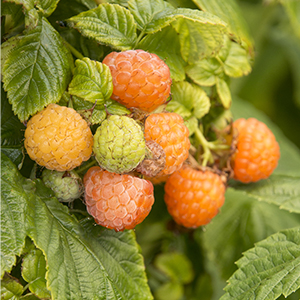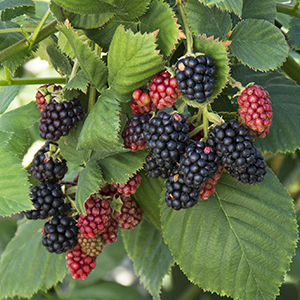There has never been a better time to add perfectly-ripe, plump, tasty homegrown berries to your garden. New, more compact-sized plants and improved varieties have made growing berries even easier and more rewarding. We grow our berries in a special soil mix crafted especially for edibles. Therefore, your plants will flower and fruit more in their first year in your garden.
If you’ve been growing berries forever, try a few of the new varieties. If you've never grown berries, make this the year. Turn your backyard into your own farmer's market with the freshest crops at your fingertips.
Berries are so easy to grow–when you know a few, old-timey tricks! These are just a few of the many excellent varieties we offer (go digging online for more). If you have questions or need specific advice for your zone, please leave a comment below.
Delightful Blueberries
Tips and Tricks: Blueberries aren’t difficult to grow, but they do have some special requirements.
Blueberries are the gift that keeps on giving. Planted in the correct location and given plenty of light and water, they will live and produce fruits for decades. Choose several varieties that fruit at different times (early and midseason) for months of berries. Include a few that have been bred to thrive in pots, for berries outside the back door.
- Choose a sunny spot. Blueberries grow in semi-shade in nature, but heavier fruiting happens with more sunshine.
- Test soil for pH (a simple kit from the garden center). Then adjust to a very acidic 4-to-5 range using sulfur (pelleted or powdered). Plants will grow in more alkaline soils, but fruiting and leaf production will likely be decreased.
- Amend soil so that it’s high in organic matter by adding well-aged compost. Blueberries thrive in infertile soils; do not add nitrogen-amendments such as manures.
- Add several inches of peat moss to the hole when planting (this is a one-time application).
- Top with a 3 inch layer of mulch (acidic is best–pine needles or pine straw for example).
- Water well and provide regular water thereafter (we recommend a drip system).
- If planting in containers, use a soil mix made for acid-lovers. Expect to water several times a week in the hottest months.

Bountiful Blue® Blueberry
Award-winner with the bluest foliage of all and a big crop of large, juicy berries on a compact shrub. Full sun. Zone: 6 - 10
Sunshine Blue Blueberry
Low-chill selection perfect for small gardens or large patio tubs sets an abundant crop of sweet fruit. Full sun. Zone: 5 - 10
PHOTO: iStock
Bountiful™ Delight Blueberry
Excellent for warm climates, performs even in extreme heat, bearing small, aromatic, sweet fruit. Full sun. Zone: 8 - 10
PHOTO: Getty Images
Luscious Raspberries
With their beautiful, jewel-like fruits (that are also high in fiber and Vitamin C), raspberries are relatively easy to grow. With proper care, these plants can bear fruit for years. Choose either traditional types with long canes or newer varieties. The later have been bred to thrive in large containers, while still providing a full crop of berries.
Tips and Tricks: Raspberries generally grow from zones 3 – 9, but you’ll need a cultivar for your climate.
- Select a site with full sun and good air circulation. If planting a variety with long canes (as opposed to the compact varieties for containers) avoid places with high winds. This can whip the canes around and damage berries.
- Select raspberry cultivars that ripen at different times to spread out your harvest.
- All varieties will begin to produce fruit in their second season; some may bear in their first autumn.
- Cold hardy ones include Willamette, Canby, Heritage; Heat-tolerant include Shortcake and Indian Summer.
- Apply compost and a little balanced organic fertilizer in late winter, if needed, for good growth.
- Mulch to discourage weeds and keep the soil evenly moist; water during dry spells.
- Pick your berries as early in the morning as possible, when they are cool. If the berries are wet, let them dry before picking.
- Here’s an excellent primer on pruning raspberries.
Rubus Heritage Raspberry
Prefers cooler Northwest or coastal conditions. Second-year growth sets summer and then fall crop. Full sun. Zone: 4 - 8

Fall Gold Raspberry
Rare gold raspberry for colder zones produce two crops each season. First in fall, and again following spring on same canes. Full sun. Zone: 3 - 8

Indian Summer Raspberry
Ever-bearing produces small crop in late spring to early summer, and larger crop in early fall. Full sun. Zone: 4 - 8
Heavenly Blackberries
Blackberries might be the easiest of berries, growing on tough, hardy plants in colder zones. They can be quite decorative, too–let them ramble over arches, pergolas, trellis and along wires on walls and fences. If you are short on space there are compact, thornless types of blackberry that will grow perfectly well in containers. We grow our blackberries on a three-piece bamboo teepee. This makes it easier for you to get them started in containers.
Tips and Tricks: From old-school brambles to new thornless compact ones, it’s all about the pruning.
- Primocanes, erect, hybrids–all have different pruning needs which, while not complicated, should be met.
- Blackberries and hybrids are all self-fertile, so you don’t need lots of plants to get good yields.
- Plant in full sun; can take some shade, but the trade-off is fewer berries. In the hottest regions, blackberries appreciate some shelter from hot afternoon sun.
- Provide well-drained soil with mildly acidic to neutral pH (about 5-to-6). Amend as needed (see blueberries).
- Water regularly during the first growing season to establish a deep, extensive root system.
- Fertilize before new growth begins in spring.
- Cover with a 3 inch layer of organic mulch annually (less if planted in a container). Make sure the mulch is placed 2 inches away from the crown to prevent rotting.
- Blackberries are ripe when they go from glossy to dull, a transition that usually takes two to three days.
Superlicious™ Blackberry
Thornless, compact dwarf fruits twice in one season. Fruits more reliably than other, similar varieties. Full Sun. Zone: 4 - 9
Prime-Ark® Freedom
Thornless Blackberry
Thornless, self-pollinating for colder zones; sets on year-old canes twice each season. Full sun. Zone: 4 - 8
PHOTO: Getty Images/iStock

Black Satin Blackberry
Thornless and heat tolerant this is a prolific producer of deliciously sweet and juicy berries in midsummer. Full sun. Zone: 5 – 8
Sweet, Sweet Strawberries
Sun-sweetened strawberries, still warm from the garden, are unsurpassed for sheer fruity indulgence. Just a few rows of plants will keep you well supplied for making into desserts or eating out of hand. If you’ve never grown berries, start with strawberries. They’re some of the easiest fruits to grow ― and one of the most productive, too.
Tips and Tricks: For prolonged productivity and unique flavors, consider growing several types.
- Strawberries die back in winter and start growing vigorously in spring, producing fruit and offspring. They typically rest in mid-summer and ramp-up again in the fall, developing latent buds that will become next spring’s flowers.
- Strawberries fall into two main types. Firstly, June-bearing that produce their crop over three weeks from late spring to early summer (good for canning or jam). Then ever-bearing (also called day-neutral) that produce a heavy set of berries in early summer. This is followed by several lighter flushes of fruits in late summer and fall.
- Plant in full sun. Provide fertile, evenly moist, well-drained soil.
- Plant the crown at soil level. After harvesting, remove old leaves with hand pruners. Leave the crown and new leaves untouched to allow sunlight into the center of the plant.
- Plant strawberries as early as six weeks before your last frost. Use row covers to protect new plantings from extreme cold and wind. In mild areas, you can plant in fall.
- Removing all runners from ever-bearing varieties will increase the production of big, juicy berries.
Albion Strawberry
Perfect dessert strawberry due to high sugar content! Everbearing, conical-shaped fruit with firm texture, superior flavor. Full sun. Zone: 3 - 9
PHOTO: Rudyanto Wijaya

Seascape Strawberry
Ever-bearing, and highly productive over a long season, yielding large, perfect, sweet berries with excellent flavor. Full sun. Zone: 4 - 9
How Many Berry Plants Should I Grow?
Sort of depends on how you want to use them. Do you want to sprinkle a few on cereal and add to fruity cocktails? (In which case one plant per person should be sufficient). Or are you planning on winning a ribbon for the best jam? (In which case, you're looking at 5 to 10 times that amount.)
Here are some general guidelines (can be more, can be less):
Blackberries – Average yield per plant is about 1 quart.
Blueberries – Average yield per plant is about 3-4 quarts.
Raspberries – Average yield per plant is about 1-2 quarts.
Strawberries – Average yield per plant is about 1 pint per plant.
Learn More
Read more:
- More about container grown berries
- Tips for growing strawberries
- Make berry "poptails"
- Tips for growing blueberries in containers
- How to design your garden landscape with fruiting berry plants
Learn more:
- See all Monrovia Plants
- Subscribe to our award-winning monthly newsletter
- Find more inspiration and ideas for plants and design on our blog
- Find a Monrovia retailer near you













Please login to comment.
Don't have an account?
Sign Up for free